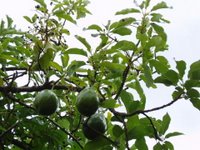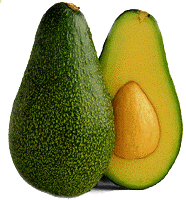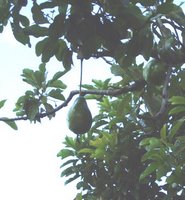[ . BACK to WORLDKIGO TOP . ]:::::::::::::::::::::::::::::::::::::::::::::::::::::::::::::::::::::::::::::::::::::::::::::::::::::
Avocado pear (Kikuyu : Mûkorobîa)
***** Location: Kenya
***** Season: Cool dry season
***** Category: Plant *****************************
Explanation
While the avocado pear is available in Kenya all year round, its main fruiting season is in July, when it is both plentiful and cheap. Avocados are sold in all parts of Nairobi, posh or slum, by basket carrying hawkers, on street stalls, in city markets, off the backs of pick-ups, and in piles on pavements. Everyone can afford an avocado, and many pick one up and have it cut into quarters, for immediate consumption as they walk on. Nairobi street food is good!
 Photo Patrick Wafula
Photo Patrick WafulaAvocado trees need a certain altitude in Kenya, and they are at their best in Murang’a, Embu and Meru, at the foot of Mount Kenya. There are many different varieties -- some are green when ripe, others black, some are smooth-skinned, others rougher. The flesh may be pale green to darker -- the black ones even have a tinge of purple. They come in various sizes too -- the small ones fitting comfortably into the palm of one’s hand, the giants weighing over a kilogramme. Some have large stones filling about half the centre, some have smaller ones, and some of the stones even roll about within the fruit, making a thudding noise. Everyone will have their own favourite variety, but all are delicious anyway.
Dogs love to lie under trees with ripening avocados -- ready to pounce on any fallen fruit and eating it with relish. Chickens too enjoy the soft flesh.
Avocados are eaten in many ways, and always in generous quantities -- from hand to mouth in the street, as an office mid-day snack, laid out on a sandwich, cut on top of traditional dishes such as githeri (maize and beans) or sukuma wiki (shredded kale), or as a key component in a fruit salad. They are delicious blended with milk and sugar as a fresh drink. The only forms in which I have never seen Kenyans eat them, are the avocado and shrimp cocktail, the hollow avocado with vinaigrette, or as a guacamole dip -- such popular starters in Europe!
Single avocado trees can be found in many gardens, where they look attractive, as evergreen trees, with clusters of flowers followed by a long growing season for the fruit. As the trees grow bigger, they are often cut back or entirely removed, since they easily outgrow small housing estate gardens. For a newcomer to Kenya, the avocado tree may resemble the mango and the macadamia nut trees, all of which have evergreen, longish, glossy leaves with clusters of flowers -- and delicious fruit!

Text and photo © Isabelle Prondzynski
xxxxxxxxxxxxxxxxxxxxxxxxxxxxx
Avocado (Persea americana)Exotic, native to the tropical Americas
A densely leafy, evergreen tree that grows to 10m or higher, widely planted at altitudes up to 2,200 m above sea level.
Bark : grey to dark brown, rough and fissured with age.
Leaves : Large; alternate; up to 20 cm long; midrib and veins prominent; glossy dark-green above; young leaves pinkish, turning bright green.
Flowers : In large terminal heads; small; abundant; pale yellow; only one in 5,000 flowers produces fruit.
Fruit : Large; round to pear-shaped; central seed surrounded by a thick layer of yellow-green flesh.
Uses : The fruit is edible, rich in fat, protein and vitamins. Its oil is used in cosmetics; dry leaves serve as fodder. The green leaves, bark and stones from the fruit are all toxic to browsing stock.
Najma Dharani, Field Guide to Common Trees and Shrubs of East Africa, Cape Town 2002.
xxxxxxxxxxxxxxxxxxxxxxxxxxxxx
Varieties of avocadoSome popular varieties of avocado are described here :
http://www.avocado.org/about/varieties.php http://www.kenyaweb.com/horticulture/fuerte.gif
http://www.kenyaweb.com/horticulture/fuerte.gifxxxxxxxxxxxxxxxxxxxxxxxxxxxxx
Avocado Receives "R" RatingIf a motion picture were produced on the history of the avocado, the film might have the dubious distinction of receiving an "R" rating for "mature audiences." The opening scene might feature a group of actors dressed like Aztecs with one pointing to a tree and exclaiming, "ahuacuatl!" Ahuacuatl is the Aztec word for testicle tree.
No doubt, the name arose because of the way the fruit of the tree hung in pairs reminding those ancient people of human male anatomy. The film might also have a scene showing the young Aztec maidens confined indoors while this erotic fruit with aphrodisiac qualities was being harvested.
Over many centuries the avocado has maintained its reputation as an aphrodisiac. During the 1920s a promotional advertising campaign was launched in the United States to deny that the avocado had aphrodisiac powers. The intent of the advertising agency was to convince people of the aphrodisiac quality by denying it. The campaign succeeded. Fortunately, in today's world the avocado has overcome its controversial past and receives a "G" rating for all ages to enjoy.
The avocado or avocado pear, Persea Americana, is native to Mexico, Central America, and South America. The earliest record of its existence was an archaeological dig in Peru that uncovered avocado seeds buried with a mummy and dated back to the 8th Century BCE. One theory was that these early people wanted the seeds buried with them because their aphrodisiac qualities might be useful in the afterlife.
Our currently popular avocado recipe, guacamole, may have originated in the pre-Columbian era. The Aztec ahuaca-mulli, avocado sauce, was prepared by mashing avocados and sometimes adding tomatoes and onions and, perhaps, coriander.
http://www.vegparadise.com/highestperch38.html

http://www.avocado.org/images/recipes/inset.jpg.................................................................................
Avocado recipes
Including the famous guacamole !:::::::::::::::::::::::::::::::::::::::::::::::::::::::::::::::::::::::::::::::::::::::::::::::::::::
 Avocado blossomskigo for short rains ***************************** Worldwide useIndiajuice at the lip-
Avocado blossomskigo for short rains ***************************** Worldwide useIndiajuice at the lip-
the kid chases the fly
coming again and again
A.Thiagarajan, India, 2006
rotten or hard
avocado in summer
seldom buttery Aju Mukhopadhyay, India, 2006
:::::::::::::::::::::::::::::::::::::::::::::::::::::::::::::::::::::::::::::::::::::::::::::::::::::
North America slices of avacado
spread a smile on her lips --
the local sushi roll"chibi" (pen-name for Dennis M. Holmes)
*****************************
Things found on the wayThe avocado tree (Persea americana), when grown by a hobby gardener is normally grown from seeds removed from ripened fruit. There are two acceptable methods of doing this, either by sprouting the seed in water or by actually planting the seed in soil.
Many people start avocado trees as novelty house plants by piercing the seed with its pointed end up, partially through with toothpicks on three or four sides to hold it on the top of a jar or vase partly with water and few pieces of charcoal (to keep the water sweet) just covering the base. In 2 to 6 weeks, when roots and leaves are well formed the plant is set in potting soil. Unless they're moved into soil within a few weeks or months after germination, they'll begin to deteriorate.
They are also easily sprouted in a well-drained 4- or 5-inch pot of porous, fertile soil. The top of the seed should just barely peek above the surface of the soil. If the soil is kept fairly moist and the temperature is between 60 and 70 degrees, the seed will begin to sprout and a pretty, leafy plant will develop.
Read more here :
http://www.thegardenhelper.com/avocado.html*****************************
HAIKUavocado tree --
the dog and I stare in vain
at its ripe fruit

Haiku and photo © Isabelle Prondzynski
xxxxxxxxxxxxxxxxxxxxxxxxxxxxx
happy looking child
eats fleshy avocado --
no hunger at lastCyprian Awino (Bamboochas)
Prize winner at the Bahati Ginkoo, Nairobi, 27 May 2006幸せな 子 アボガド食べる 飢えは無し
shiawase na ko abogado taberu ue wa nashi
(Tr. Nakamura Sakuo)xxxxxxxxxxxxxxxxxxxxxxxxxxxxx

Photo Patrick Wafula
avocados are back --
trucks overloaded with them
fruit sellers scrambleCatherine Njeri (Bamboochas)
xxxxxxxxxxxxxxxxxxxxxxxxxxxxx
August heat --
another avocado
on the groundSUE
http://haiku.cc.ehime-u.ac.jp/shiki.archive/0009/0085.htmlxxxxxxxxxxxxxxxxxxxxxxxxxxxxx
avocado
sprinkled with lime -
a sip of white wine ...bob richardson
http://tinywords.com/haiku/2004/07/09/?comments=all:::::::::::::::::::::::::::::::::::::::::::::::::::::::::::::::::::::::::::::::::::::::::::::::::::::
a pale shoot sprouts
from an avacado seed-
broken flower pot Andrew Otinga, Kenya
Ocotber 2010:::::::::::::::::::::::::::::::::::::::::::::::::::::::::::::::::::::::::::::::::::::::::::::::::::::
Some Avocado Haiku from the Nairobi Haiku Clubsno ghee for bread--
green fleshy avocado
is sweet every morning
happy fatty girl
peels fleshy avocado
ready to bite it
my avocado
is oval shaped green fleshy--
I salivateCyprian Awino
 Photo Patrick Wafula
Photo Patrick Wafula
a happy fatty man
selling avocados --
booming businessPhilip Kaseko
 Photo Patrick Wafulahappy looking child
Photo Patrick Wafulahappy looking child
eats fleshy avocado --
no hunger at last~ Cyprian Awino (Bamboochas)
avocados are back--
trucks overloaded with them
fruit sellers scramble~ Catherine Njeri Maina (Bamboocha)
a customer gently
touches an avocado --
how much is it?~ Lameck Odhiambo (Bamboocha)
Baba Jimmy
buys an avocado and happily
peels it for his son
~ Fan (Falcon)
overripe avocados
under the big green tree --
rural dogs feast
~ Bonface (Falcon)
avocado seeds --
farmers busy in nurseries
for better plantations~ Jelida Kerubo (Peacock)
a piece of avocado
on a man's moustache--
after lunch
guavas sitting
side by side with avocados --
the market stalls
~ Patrick Wafula (Patron, Bamboochas)
:::::::::::::::::::::::::::::::::::::::::::::::::::::::::::::::::::::::::::::::::::::::::::::::::::::
Read more Avocado Haiku from the Kenya Haiku Clubs HERE ! *****************************Related words*****
[ . BACK to WORLDKIGO . TOP . ]:::::::::::::::::::::::::::::::::::::::::::::::::::::::::::::::::::::::::::::::::::::::::::::::::::::























